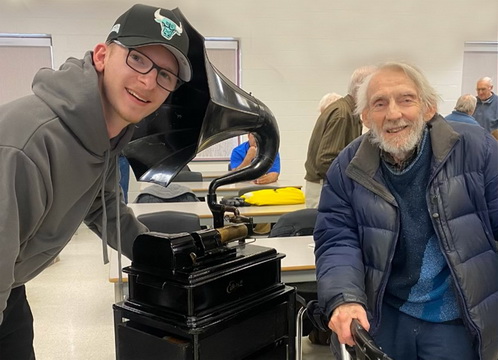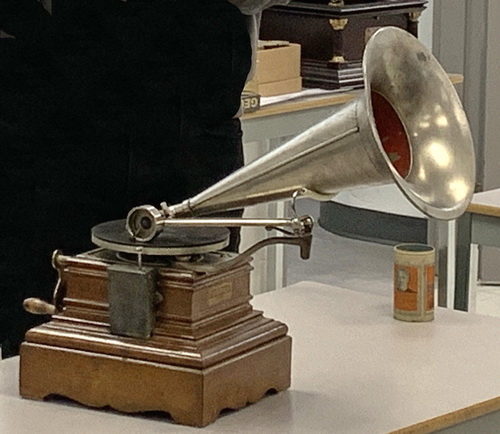|
Phonograph Show & Tell:
Some Very Unusual and Beautiful Machines
by Aleksander Witkowski
Bettini Micro-Phonograph
Mark Caruana-Dingli

|
|
Gianni Bettini is considered the first true audiophile. A wealthy Italian immigrant to New York in the 1890s, he was an avid opera-goer who devoted his
inventive genius to capturing the voices of many of the famous opera singers
from the Metropolitan Opera as well as touring European artists who visited
his salon near the New York stages.
Bettini, dissatisfied with the recording quality of his time, was driven to develop new recorders and reproducers,
which he patented as the "Micro-Phonograph." Designed for compatibility with existing Edison phonographs and Columbia Graphophones, he began marketing them
in the late 1890s from his salon
and phonograph laboratory, located near New York Theater District.
Bettini Micro-Phonograph

|
|
To improve upon the early glass
diaphragms in use, Bettini’s Micro-Phonograph recorders and reproducers featured larger mica or aluminum diaphragms, with the stylus attached to his patented “spider” mechanism, resulting in louder and higher-fidelity recordings.
Following his modest success in the United States, Bettini relocated to
Paris, France, in the early 1900s to continue producing high-quality recording equipment and capturing the voices of notable figures. Although
Bettini is best known for his micro-phonograph recorders and reproducers, he also marketed a few phonograph models, possibly manufactured
by companies such as Pathé and Phenix.
The machine shown here appears to be a French copy of the Columbia Graphophone Model B produced for Bettini.
The reproducer is
a small version of
Bettini’s micro-
phonograph reproducer, similar
to one which was
also licensed by
Bettini to Pathé.
Pathé Frères Travelling Portable Phonograph Outfit
This exceptional Pathé machine case, dating back to around 1898, is in remarkable condition with a luxurious red plush interior. What makes this particular example truly unique is the embossed writing on the red silk—a rare feature, as most cases of this type are typically plain.
Designed for convenience, the case
holds everything needed for an enjoyable
gathering at a friend's house, including
records, reproducers, and even the horn,
all fitting neatly inside. The machine itself is beautifully nickel-plated and closely resembles the early Graphophone
Type B model.

|

|
|
Edward Moran and his Pathé Frères Travelling Portable Phonograph Outfit
|
|
Peter Pan Alarm Clock
The "Peter Pan" series consisted of portable talking machines produced in Europe. This particular model, dating to
around 1929, featured an innovative
design where an alarm clock triggered the record
instead of ringing a traditional bell.
The most common "Peter Pan Gramophones" were
the "Cameraphones"—compact talking machines
designed to resemble cameras when closed.
Peter Pan Alarm Clock

|
|
Aleksander Witkowski & Paul Dodington

|
|
Edison School Phonograph
This exceptionally rare Edison Schoolhouse Opera
phonograph was available from 1912 to 1914, originally selling for $75. Designed for classroom use, it
was mounted on a steel stand with casters for easy
mobility. The unit featured four shelves, each containing boxes that could hold 24 cylinders.
Edison did not assign a dedicated block of serial
numbers for School Phonograph production, so
their numbers are intermixed with standard Opera
models. The machine is constructed entirely of
steel, finished in black enamel to match its stand,
and comes with a distinctive 10-panel Cygnet horn.
With only 35 known examples worldwide—and the
only complete example documented in Canada—this
phonograph is highly sought after and incredibly valuable among collectors today.
Zonophone Coin Operated

|
|
Zonophone Coin Operated
E.M. Prescott's International Zonophone Company
(1900–1903) marketed a range of Zonophone disc
talking machines in Europe, often resembling—but
not directly copying—models from the American catalog. Notably, a coin-operated version like this was
never offered in the United States.
This particular model features a Type C Zonophone
mounted on a scalloped wooden base that discreetly
houses the coin drawer. Interestingly, a non-coin-operated version of the Type C cabinet was briefly available in the U.S. following the bankruptcy of the National
Gramophone Corporation in September 1901.
Lioret No. 2 Cylinder Phonographe

|
|
Lioret No. 2 Cylinder Phonographe
Henri Lioret followed his father as a clockmaker.
As soon as he had finished his studies, he
moved from the French countryside to Paris and
set up shop. He had an inventive spirit and
worked on improvements to travelling clocks and
watch movements with alarms. He opened a
clockmaking school that became highly reputed
and he won a contract to build a special ornate
clock for the Russian Czar Nicholas II.
At the 1889 World’s Fair in Paris, Edison was
showcasing his Tinfoil Phonograph and his new
Class M, “The Perfected Phonograph”. Another
display of Edison prototypes included a Talking
Doll with cylinders recorded in French for the occasion. The doll was launched in 1890, but was withdrawn from the
market after only a few weeks as a complete failure. Emile Jumeau, the
maker of high quality dolls, had seen the Edison doll prototype at the
World’s Fair and decided that doing something similar would give him a
competitive advantage over his German doll-making competitors.
Mike Bryan

|
|
He knew
of Lioret’s reputation and approached him to design a miniature mechanism that would fit inside a doll’s body. Lioret was immediately inspired by
the idea and decided to switch his focus from clockmaking to phonograph
development. To avoid Edison’s patents, he knew he had to design an original phonograph.
He learned from the failure of Edison’s Talking Doll and was inspired to
make a better one. In 1893 he began producing his Lioret phonograph doll
and the very first celluloid cylinders that played for 30 seconds. In 1894 he
used the same mechanism to make a cardboard box version of the phonograph, Le Merveilleux. It had a resonator and clear celluloid cone as the
horn. In 1895 Lioret introduced the No. 2 Model, a more robust machine
that would play Lioret’s #1 30-second cylinders and #2 60-second ones.
Initially, the phonograph was provided with the same resonator and clear
celluloid cone horn as Le Merveilleux. It could be purchased in a black carrying case
lined with
red or green
velveteen. In 1896 the spindle was lengthened to
accommodate the new #3 cylinders that played for
1m 30 seconds.
Then in 1897, making a further effort to enhance the value and amplify the sound of
the phonograph, Lioret offered a conversion kit that
included a black lightweight aluminum corrugated
Type A horn to replace the resonator/celluloid cone,
and a red or green velveteen-covered board on which
it could be mounted. New Lioret No. 2s could now be
purchased as #2Bs in this style
Lioret No. 2 Cylinder Phonographe

|
|
It is estimated that 1500-2000 Lioret #2s were
made, but there are very few survivors of the board-
mounted #2Bs. Its advanced high quality clocklike mechanism and materials made it expensive at 200 French francs. By 1899 Pathé was offering its copy of the Columbia Eagle for just 65 French francs, so Lioret responded with new cheaper models, the Lioretgraph A at 90
French francs and Lioretgraph B for 100 French francs. Although Lioret tried to compete by introducing more new
models, they struggled against the new, cheaper mass market phonographs that began to dominate the market
around the turn of the century. By 1904 Lioret was exiting from the phonograph business and turning to other inventive pursuits, defeated perhaps, but having made a lasting impression with his creative and innovative approach
to the reproduction of sound.
Ohio Arts 1967 Mighty Tiny Record Player

|
|
Ohio Arts 1967 Mighty Tiny Record Player
The Mighty Tiny Record Player, produced by Ohio Arts in
1967, was a remarkable toy that truly lived up to its name.
Marketed as the world's smallest record player, it featured
a miniature electrically powered turntable and built-in
speaker
Despite its compact size, the player was capable of playing special 2 ¼-inch Mighty Tiny records. The selection
was surprisingly diverse for a toy, offering genres ranging
from African drums and Italian strings to Arab Desert
Dance, The Harmonettes, and Sax Rock.
The mechanism functioned by engaging the needle with
the record when the lid was closed. Each record provided
a brief but enjoyable listening experience, playing for
approximately 30 to 40 seconds.
Soundwagon Bus
The Soundwagon Bus is a unique and highly collectible toy record player,
often fetching high prices when listed on eBay. Designed to play 33 1/3 rpm
vinyl records, this miniature bus operates by driving around the record’s surface while a needle underneath tracks the grooves.

|

|
|
Soundwagon Bus
|
|
|